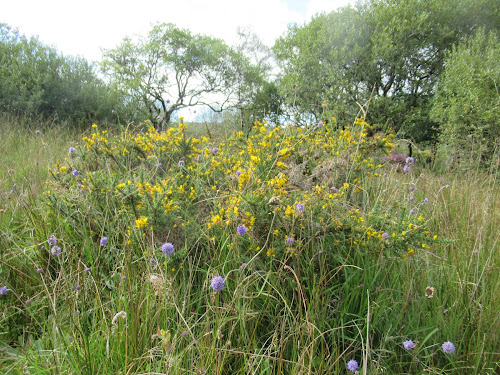Looking for Marsh Fritillary Webs
Fritillary butterflies have the same allure as orchids in the plant world. They are distinctive, rather local to distinctly rare, and not very easy to identify unless you have a good view. It is said that they perhaps get their name because their variety of chestnut and black chequer markings are, with a bit of poetic licence, reminiscent of the chequer markings of the Fritillary flower, but I think it’s more likely that both flower and butterfly have the same name because fritillus is Latin for chequered.
 |
| Fritillary, very rare in Britain now, but often grown in gardens. |
There are eight resident fritillary butterfly species in the UK, but over 40 in Europe, posing an even greater challenge if you want to name them. Like so much else in the natural world, they are becoming scarcer. Probably the most widespread in the SW is one of the biggest, the Silver-washed Fritillary.
 |
| Silver-washed Fritillary |
It can be seen in the later part of summer mainly in woodland clearings with a characteristic lilting flight mostly higher up in the foliage.
Small Pearl-bordered Fritillary
This species can be found in small colonies in places in the UK but is declining.Heath Fritillary
One of our rarest butterflies, it occurs in a handful of sites in Southern Britain, saved from extinction by careful conservation. It is common and widespread in many parts of Europe.
 |
| Heath Fritillary |
Marsh Fritillary
Unlike the Heath, this Fritillary is rare and endangered in both Britain and Europe. It was this last species that took a small group of us up onto the marshy eastern edge of Bodmin Moor one sunny September afternoon.
 |
| Looking for Marsh Fritillary caterpillar webs, Bodmin Moor |
We were looking for the webs made by the young caterpillars of the Marsh Fritillary. They make their sheltering web low down in their foodplant, Devils bit Scabious.
 |
| Devil's-bit Scabious and late- summer flowering Western Gorse. |
Marsh Fritillary caterpillar web.
They over-winter in this little tent. The marsh had been lightly grazed by bullocks quite recently but there was still a good mix of vegetation of various heights in this sheltered and relatively warm corner of the edge of Bodmin Moor. Among the scatter of golden-flowering Western Gorse, Willow and Birch scrub there are rushes and grasses, with the silky white heads of Cottongrass here and there. Devil’s Bit Scabious was still in flower and there were rags of old Marsh Thistles. Lower down the slope were a lot of golden seed spikes of Bog Asphodel, old seed spikes of the earlier-flowering Heath Spotted and Marsh Orchids and further still, abundant patches of ling and of bright green bog moss (sphagnum) and droplet-spangled Sundew.
 |
| Ling.(Calluna vulgaris) |
 |
| Sundew(Drosera rotundifolia) an insectivorous plant. |
On this year's search we were out of luck. But the abundant Silver Y moths, coloured butterflies and handsome spiders waiting for a passing fly to trigger their trip wires slung across the gaps between rush stems, with the benign sun warm on our backs, was pleasure enough.
Two or three years ago, following June sightings of several of the adults, we did indeed find several webs with groups of young caterpillars in their webs. As we were making our way slowly back to the moor gate Tony found another, bigger web with at least a dozen, still small, caterpillars visible and traces of the successive web building below the one in current occupation.
Some were eating the skeletonised remains of a Scabious leaf beside their web. We were told they need to feed up more yet and have another skin change before they are robust enough to hibernate over winter. Next spring they will feed again, undergoing another couple of skin changes before dispersing, pupating and emerging as adults in June/July to repeat the cycle.




Very interesting Mary - thank you
ReplyDelete